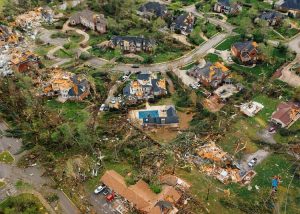When natural disasters like hurricanes and tropical storms strike New Orleans, property owners are often left with significant wind damage and water damage. In these situations, it’s crucial to understand the difference between wind damage and water damage claims, so you can work effectively with your insurance company to receive the compensation you deserve. As your trusted New Orleans Personal Injury Attorney, Cueria Law Injury Lawyers LLC is here to guide you through the process and ensure your rights are protected.
Key Differences Between Wind Damage and Water Damage Claims
Wind Damage Claims
Wind damage occurs when high winds from hurricanes, tropical storms, or nor’easters result in damage to your property. This can include damage to your roof, siding, windows, or other structural elements. A wind damage claim is filed under your homeowners or commercial property insurance policy.
Water Damage Claims
Water damage refers to damages caused by water entering your property from the ground up due to heavy rainfall, storm surge, or the overflow of a body of water like a lake or river. In these scenarios, you would file a water damage claim under your National Flood Insurance Program (NFIP) policy.
Primary Keyword: New Orleans Personal Injury Attorney
Secondary Keyword: New Orleans Hurricane Attorney
Distinguishing the Cause of Damage

It’s essential to identify the precise cause of damage to your property, as this will determine which type of claim you should file. While your flood insurance policy covers physical damage directly caused by flooding, your homeowners or commercial property insurance may cover damage from other perils, such as wind-driven rain or fire.
Direct Result of Flooding
If river overflow, heavy rainfall, or storm surge causes water to enter your property, this is considered a direct result of flooding and would typically be covered under your flood insurance policy.
Wind-Driven Rain
When rain is propelled into your covered structure by wind, this is considered wind-driven rain and is not covered under your flood insurance policy. Instead, you would file a claim with your homeowners or commercial property insurance.
Water Damage as a Result of Wind Damage
If your roof is damaged by wind, allowing water to enter your property through the ceiling, this is considered water damage as a result of wind damage. In this case, you would need to file a claim with your homeowners or commercial property insurance, as it is not covered under your flood insurance policy.
Reporting and Documenting the Damage
Taking quick action when filing a claim for wind or water damage is essential to regain control of your property and your life. Follow these steps to ensure a smooth and efficient claims process:
Step 1: Contact Your Agent
As soon as you notice any damage, contact your insurance agent or insurance company directly to start the claims process. Provide the name of your insurance company, policy number, and contact information when making a claim.
Step 2: Separate Your Property
Separate damaged property from undamaged property and take photographs and videos of the damaged items, including any items you plan to discard. Dispose of any materials or items that may pose health risks or collect mold.
Step 3: Preserve and Protect Undamaged Property
Take measures to preserve and protect undamaged property, but do not sign any agreements or contracts for cleaning, remediation, or maintenance services before consulting with your adjuster or insurer to ensure these services are covered.
Step 4: Minimize Mold Growth
After a flood, it’s crucial to minimize mold growth and spread as much as possible. Flood and property insurance policies do not cover mold damage if a policyholder fails to take action to prevent the growth and spread of mold.
Step 5: Record Damage
Take photographs and videos of all wind damage and water damage inside and outside of your property. As you assess your property, make a list of structural damage you want to point out to your insurance adjuster(s).
Step 6: Document Damaged Property
If you have purchased flood insurance contents coverage, make a list of your damaged property for your adjuster. Be sure to include the quantity, description, brand name(s), location of the item in your building, and your estimate of the loss amount.
Working With Your Adjuster(s)
Step 1: Schedule a Property Visit
Your adjuster will contact you after receiving your notice of loss to set a time for a property visit. During the initial visit, they will take measurements and photographs to document the damage. You may want to ask if you are eligible for a remote visit or advance payment.
Step 2: Additional Visits and Consultations
Your adjuster may need to consult with other adjusters and claims personnel during the settlement of your claims and may require additional visits to your property.
Step 3: Receive a Detailed Damage Estimate
The adjuster will use the information collected during the visit(s) and the documentation you have provided to complete a detailed damage estimate. You will receive a copy of this estimate, which can help inform repair work appraisals from licensed professional contractors.
Beware of Scammers
Be cautious of scammers who may try to take advantage of your situation. When an adjuster visits your home, you should not be asked to provide confidential information, such as your social security number or bank account numbers.
Seeking Additional Support

For additional support filing your claim, contact FEMA Mapping and Insurance eXchange (FMIX) at FEMA-FMIX@fema.dhs.gov or by calling 877-336-2627. If you use a relay service, such as video relay service (VRS), captioned telephone service, or others, give FEMA the number for that service.
Choosing the Right New Orleans Personal Injury Attorney
When dealing with wind damage and water damage claims, it’s essential to have a knowledgeable and experienced legal team on your side. Cueria Law Injury Lawyers LLC, a leading New Orleans Personal Injury Attorney, is here to help you navigate the complex process and ensure you receive the compensation you deserve. With our expertise as a New Orleans Hurricane Attorney, we will guide you through every step of the wind damage and water damage claims process and provide the support you need during challenging times.
Do not hesitate to reach out to Cueria Law Injury Lawyers LLC for assistance with your wind damage and water damage claims. With our dedication and commitment, we will ensure your rights are protected and that you receive the compensation you rightfully deserve for these wind damage and water damage claims.







